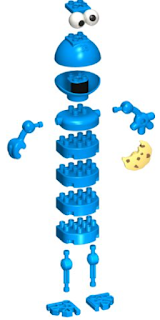 |
| Wash My Pants - Simple laundry themed game. |
Interesting thing, the name of the game on the box in the image above (from Amazon) is Wash My Pants. My box front, which appears to be the same game, says Wash My Underpants.
When I first saw the box I thought Wash My Underpants was a pretty tacky name, but then wondered if it might be a game to teach kids about sorting laundry. Nope, it's a simple game with a laundry theme. I'm glad they changed the name. I cringe at the thought of a parent asking a child what they did in OT today, getting that response, and wondering what was going on. Unless you are actually working on doing the laundry, that would, and should, raise some questions. So from here on out I am going to just call them "pants".
There are 36 pieces total, six different shapes and six of each shape. None of them match in color and design. All pieces are made of a coated, sturdy card stock.
Object:
Be the first person to fill your laundry basket with nine pair of clean pants.
Set up:
Place the washing machine front on the stand and turn all 36 pair of pants face down on the table. Give each person a clothes basket card. Distribute the pants evenly between all players. Players turn all their pants face-up.
Play:
Each player, in turn, will start his turn by spinning the spinner to find out what he will be doing. Here are the options on the spinner:
- Color block - red, green, purple, yellow, pink, and blue. One space for each color. If you land on one of these colors and you have a pair of pants with that color, place them into the washer.
- Star - If you land on this space you can trade one of your pair of pants for someone else's. Not sure of the purpose of this. Maybe so that you will have a set ready to play.
- Bubbles - There are three spaces with bubbles and if you land on one, yell "Wash my pants!" Then take out any pants that are in the washer and place them on your basket card.
Keep playing until one person has filled his laundry basket with pants and is declared the winner. Because of the way the spinner is made, it works best when it is sitting flat on the table, but you can also use it with two hands.
Try this:
- Sort the pieces by shape.
- Play in conjunction with teaching another skill such as dressing, putting dirty clothes into a laundry basket, or doing laundry.
- Use smaller wooden clothespins and clip pairs of pants onto the side of a box or across a cord you have strung.
- Play a cooperative game and fill all four laundry baskets together, taking turns with the spinner. Place the pant pieces flat on the table and pick them up where they lie, without the aid of pulling them to the edge of the table.
- Isolate different fingers to flick the arrow on the spinner.
- Make a nice O in the web space before flicking the arrow on the spinner.
- Place the pant pieces upside-down (color side up) on the playing surface. Pick up each piece and turn it in-hand to orient it right-side up for placement in the basket.
- Place all the pants randomly on the table top, color side up. Describe a piece and ask the player to find it. For instance, find the purple pants with the purple dots.
- Place all the pants randomly on the table top, color side up. Sort them by color. For instance say "Let's wash all the yellow pants first" and ask the player to pick up any pair of pants that has yellow in them. You could stand the washer in the box and put each color through the hole (they will land in the box) while putting the game away.
- Take turns trying to throw the pants into the hole in the washer.
- Line up the four baskets and sort by color. All pants with green in one basket, all pants with blue in another, etc.
- Place all the pants randomly on the table top, color side up. Put the pants away by color. Call a color (or use the spinner to determine the color) and see how many pairs the player can pick up in one hand, squirreling them into the palm as they go. Drop them into the box by handfuls.
- Work
on visual discrimination, figure ground, eye-hand coordination, manual
dexterity, isolating fingers to thumb, web space development,
coordinated use of both hands, social interaction skill, process skills,
play and leisure exploration and participation
In the box: 4 laundry basket cards, 36 pairs of (under)pants, 1 washing machine and stand, 1 spinner







